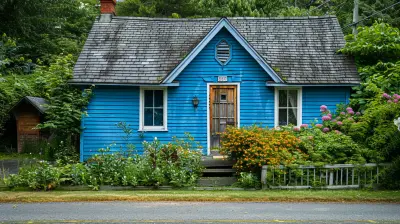18 April 2025
Buying a new home is an exciting step, but let’s be honest—it’s also pretty stressful, especially when it comes to pulling together that hefty down payment. Unless you’ve got a suitcase full of cash sitting under your bed (and if you do, call me, we need to talk), you might be exploring other ways to fund it. Enter the HELOC—a Home Equity Line of Credit.
Wait, what’s a HELOC? Basically, it’s like having a big, reusable credit card that’s tied to the equity in your current home. It's flexible, convenient, and could be just the ticket to snagging your dream home. But, in true real estate fashion, there are pros, cons, and “gotchas” to consider.
So, let’s break this down. How can you use a HELOC to fund your next home’s down payment? Here’s everything you need to know, step by step. 
What Is a HELOC and How Does It Work?
Before we dive into the nitty-gritty, let’s start with the basics. A HELOC stands for Home Equity Line of Credit, which is essentially a revolving line of credit that you can tap into based on the equity you’ve built in your current property.Think of it this way: if your house were a piggy bank, a HELOC is like cracking it open, taking what you need (but not all of it), and putting the rest back. You’re borrowing against the value of your home, minus how much you still owe on your mortgage.
Here’s an example:
- Let’s say your home is worth $400,000.
- You owe $200,000 on your mortgage.
- That gives you $200,000 in home equity.
- Most lenders let you borrow up to 80–90% of your equity, which means you could potentially access $160,000–$180,000.
Not too shabby, right? Of course, you don’t HAVE to use the full amount. It’s a line of credit, which means you borrow only what you need and pay interest only on what you’ve borrowed. 
Why Use a HELOC for a Down Payment?
Here’s where the HELOC gets interesting for homebuyers: it can be a game-changer, especially if you’re looking to buy a second home, upgrade your current living situation, or invest in a rental property.1. Avoid Draining Your Savings
No one likes being broke. Using a HELOC means you don’t have to empty your savings account for the down payment. You’ll still have funds on hand for moving costs, home repairs, or that celebratory pizza party after you close on the house.2. Flexibility
You can borrow exactly what you need for the down payment, whether it’s $20,000 or $100,000. Plus, you can access the funds as needed, rather than pulling out one lump sum. It’s like having financial training wheels.3. Lower Interest Rates
Compared to personal loans or credit cards, HELOCs typically come with much lower interest rates because they’re secured by your property. This can save you a boatload of money over time.
Steps to Use a HELOC for Your Next Down Payment
Alright, let’s talk logistics. How exactly do you use a HELOC to fund your down payment? Follow these steps:1. Check Your Equity
First things first: how much equity do you have in your current home? Use this simple formula:
Home’s Current Market Value – Mortgage Balance = Home Equity
If you’re not sure about your home’s market value, you can get an appraisal or use online tools like Zillow or Redfin for a ballpark estimate.
2. Shop Around for Lenders
Not all HELOCs are created equal. Different lenders offer varying interest rates, fees, repayment terms, and borrowing limits. Shop around! Look for one with competitive rates and terms that fit your financial situation.Pro-tip: Start with your current mortgage lender. Sometimes they offer discounts or faster approvals for existing clients.
3. Get Pre-Approved for the HELOC
Getting pre-approved is a lot like applying for a mortgage. The lender will check your credit score, income, debt-to-income (DTI) ratio, and the value of your home. Have your financial ducks in a row—it’ll speed up the process.4. Access the Funds
Once you’re approved, the lender will set up an account for your HELOC. You can draw funds as needed (similar to how you’d use a credit card). Most HELOCs come with a draw period (usually 10 years), during which you can borrow and repay repeatedly.5. Use the HELOC for Your Down Payment
This is the fun part—using your HELOC to fund the down payment for your next home! Work with your real estate agent and lender to make sure the funds are transferred in time for closing.
Things to Watch Out For
As awesome as HELOCs can be, they’re not without risks. Here are some potential pitfalls to keep in mind:1. Variable Interest Rates
Most HELOCs have variable rates, which means your monthly payments could go up if interest rates increase. It’s like a surprise party you didn’t ask for (and don’t want).2. Risking Your Current Home
Remember, your HELOC is secured by your current home. If you can’t repay it, you could risk foreclosure. Yikes! Make sure you borrow responsibly.3. Overborrowing
Just because you can borrow a big chunk of cash doesn’t mean you should. Be strategic—only borrow what you need and what you know you can repay.4. Closing Fees and Other Costs
Some HELOCs come with fees for closing, maintenance, or even early repayment. Don’t forget to read the fine print (or have your lender explain it to you).HELOC vs. Other Funding Options
Thinking about other ways to fund your down payment? Let’s compare:Savings
- Pros: No interest, no fees, no risk to your current home.- Cons: Draining your savings could leave you financially vulnerable.
Personal Loan
- Pros: Quick and easy to get.- Cons: Higher interest rates than HELOCs, plus strict repayment terms.
Gifts from Family
- Pros: Free money! (Thanks, Grandma!)- Cons: May not be enough to cover the full down payment.
Is a HELOC the Right Choice for You?
Using a HELOC for a down payment isn’t for everyone, but it CAN be a solid option if:- You have plenty of equity in your current home.
- You’re confident you can handle the monthly payments.
- You’re okay with the risks and potential variable rates.
On the flip side, if your finances are tight or you’re already juggling debt, a HELOC might not be the best move.
Final Thoughts
A HELOC can be a powerful tool to help you fund the down payment on your next home, but it’s not a “one-size-fits-all” solution. The key is to weigh the pros and cons, understand the risks, and make sure it aligns with your overall financial goals.So, what do you think? Ready to make your next move? With a little planning and the right strategy, your dream home could be just around the corner.






Quade Vance
Great insights! Using a HELOC for a down payment is a smart strategy. Thanks for shedding light on this option for prospective homebuyers!
April 24, 2025 at 10:48 AM